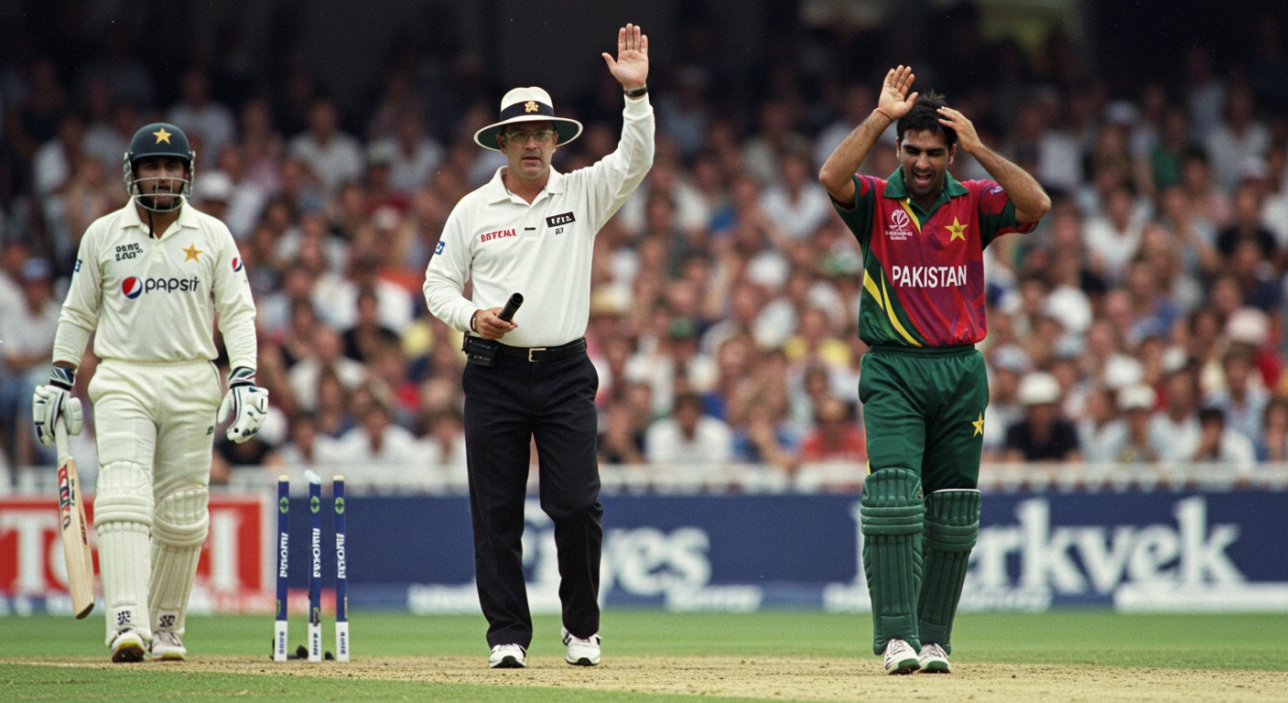
Weirdest Dismissals in Cricket You’ve Probably Never Seen
For all its traditions, tactical layers, and deeply codified laws, cricket is still a game that regularly throws up the bizarre. It’s a sport where centuries can be scripted with surgical precision, yet wickets can fall in ways no coach, analyst, or captain could ever predict. And nowhere is that more apparent than in the weirdest dismissals in cricket history—moments that defy logic, mock preparation, and make the most professional players look like Sunday amateurs.
These aren’t just fringe cases buried in an obscure MCC appendix. They’ve unfolded under floodlights, in front of sell-out crowds, with television cameras capturing every second of the absurdity. They’ve happened in Test matches, in World Cups, in domestic T20s. And every time, they provoke the same reaction: open-mouthed laughter from fans, stunned silence from players, and a panicked search through the Laws of Cricket from commentators trying to explain what just happened.
Some dismissals are down to sheer bad luck—a ricochet off a helmet, a freak rebound off a non-striker’s bat. Others are rooted in mental lapses, like batters wandering out of their crease mid-celebration, or bowlers appealing before finishing their action. A few stem from unusual interpretations of rarely used laws: hit wicket off a reverse sweep, timed out after misjudging the drinks break, or obstructing the field by instinctively swatting the ball away.
But all of them share one thing—they remind us that cricket, even at its most elite level, still has room for farce. These dismissals exist in the margins of the game, where logic short-circuits, and where players are left either embarrassed or laughing along with the crowd. This article revisits some of the strangest individual dismissals ever recorded—real moments, not folklore, that no batter trains for and no bowler plans for. They are the glitches in cricket’s matrix. And they’re absolutely glorious.
Inzamam-ul-Haq – Obstructing the Field, 2006

One of the most memorable—and absurd—dismissals in modern international cricket came during an ODI between India and Pakistan in Peshawar. Inzamam-ul-Haq, Pakistan’s captain and known for his laid-back style and frequent involvement in run-outs, added another unusual dismissal to his name: out for obstructing the field.
Suresh Raina threw the ball towards the stumps from short mid-off while Inzamam, having left his crease momentarily, tried to defend himself. Rather than stepping back in or avoiding the throw, he bizarrely raised his bat and blocked the ball like a goalkeeper. India appealed. The umpires conferred. And Inzamam was given out under Law 37—obstructing the field, having wilfully interfered with a ball in play.
It was not malicious, but the laws were clear. Intent was all that mattered. Inzamam, stunned but calm, walked off to a chorus of disbelief and laughter. It was a rare reminder that, even in international cricket, reflex actions can have unexpected consequences.
Andrew Symonds – Hit Wicket While Ducking, 2005
Andrew Symonds was known for his power-hitting, athletic fielding, and no-nonsense attitude. But during an ODI against Sri Lanka in 2005, he found himself dismissed in a way that even he would have struggled to explain with a straight face.
Facing a short ball from Chaminda Vaas, Symonds ducked under it as it passed harmlessly over shoulder height. The delivery was unremarkable. What followed was not. As he dipped, his helmet clipped the top of the stumps. The bails dislodged. He hadn’t played a shot. The ball hadn’t hit him. But the contact with the stumps was clear, and he was correctly given hit wicket.
There was no drama. Just confusion. Symonds turned around in disbelief, glancing at the fallen bails, then walked off with a shake of the head. In a career filled with sixes and diving stops, this was the dismissal that drew the biggest double-takes.
Allan Donald – Run Out Without His Bat, 1999 World Cup Semi-Final
One of the most iconic and heartbreaking dismissals in World Cup history came not from a spectacular ball, but from a moment of pure chaos and miscommunication. During the 1999 World Cup semi-final between South Africa and Australia, with scores level and one run needed for victory, Allan Donald found himself at the centre of a sporting meltdown.
Lance Klusener, South Africa’s finisher-in-chief, had just cracked two boundaries to bring the match within touching distance. On the fourth ball of the final over, he drove to mid-off and set off for a suicidal single. Donald, at the non-striker’s end, initially didn’t run. Then he did—but far too late. And in the panic, he dropped his bat.
As Australia’s fielders calmly relayed the ball back to Adam Gilchrist, Donald was still metres short of the crease, his bat on the turf behind him. He was run out without ever having made an attempt to ground himself properly. South Africa were eliminated on the basis of a tie, and Donald’s dismissal—a mix of hesitation, miscommunication, and the absence of a bat in hand—became one of the most replayed moments in cricket history.
It wasn’t just weird. It was tragic. And it changed the way teams handled running between wickets under pressure forever.
Mark Richardson – Out for Cramping Up Mid-Run, 2004

During a Test match between New Zealand and India in Mohali in 2003, opener Mark Richardson became the unlikely protagonist in one of the strangest run-outs the game has seen. Batting on a hard-fought 145, Richardson drove a ball wide of mid-on and set off for what looked like an easy single.
Halfway down the pitch, he suddenly pulled up—grimacing, hopping, and visibly struggling. He had suffered an intense bout of cramp mid-run. As he stumbled, dropped his bat, and tried to limp through, Mohammad Kaif fielded cleanly and threw the ball in. The bails were whipped off with Richardson stranded well short.
Being dismissed due to cramp isn’t listed in any lawbook, but this wasn’t a medical retirement—it was a regulation run-out. The cause of the delay was irrelevant. He hadn’t completed the run. The fielding team had done their job.
Richardson’s innings was gritty, old-school, and physically draining. But the final image—of him crumpled on the turf, batless, as the fielding team appealed—was as bizarre as it was unfortunate.
MS Dhoni – Run Out via Helmet Deflection, 2012
MS Dhoni was known for his running between wickets—sharp turns, quick acceleration, and the ability to sneak singles where none seemed available. But in a 2012 ODI against England in Mumbai, even he wasn’t immune to an unthinkable twist of fate.
Dhoni pushed the ball to point and set off for a tight second run. The fielder, Samit Patel, aimed a sharp throw toward the striker’s end. The ball struck Dhoni on the back of the helmet, deflected directly onto the stumps, and dislodged the bails. There was no appeal. The third umpire was consulted. And the replays confirmed that Dhoni’s bat was short of the crease at the time of impact.
It wasn’t obstruction, wasn’t a deflection off the bat, and wasn’t an intentional act. It was a freak bounce off protective equipment, and by sheer coincidence, the ball travelled exactly where it needed to.
It was a legal run-out. But one that left both teams stunned at the sheer improbability of it.
Joe Root – Run Out While Celebrating a Century, 2013 (Almost)
While not technically dismissed, this near-miss is worth including for how easily it could have become one of the strangest run-outs in cricket history. During a 2013 county match for Yorkshire, Joe Root reached his century and began celebrating mid-pitch—bat raised, helmet off, and walking away from his crease. The ball, still in play, was returned quickly to the stumps by a sharp-thinking fielder.
Root hadn’t grounded his bat. The appeal didn’t come in time, but had it been made, the laws would have allowed for his dismissal. A batter is not immune just because they’ve completed a run—they must still remain within their ground while the ball is live.
Root was lucky. The incident served as a high-profile reminder that in cricket, even celebrations come with rules.
Mohinder Amarnath – Hit Wicket After Kicking the Stumps, 1986

In a Test match against Australia in Perth, Mohinder Amarnath produced a dismissal that combined frustration, bad luck, and the Laws of Cricket in equal measure. Facing aggressive pace and short bowling, Amarnath lost patience. After fending off another bouncer, he instinctively kicked his leg back in irritation—only to dislodge the bail with his heel.
There was no doubt about the contact. The umpire raised his finger. Amarnath had not been bowled, not run out, not caught—but had dismissed himself by kicking over his own stumps in a moment of annoyance.
It was ruled as hit wicket, a dismissal usually reserved for accidental touches with the bat or foot while playing a shot. This, however, was an emotional reaction. Legal, yes. But deeply unusual.
Kurtis Patterson – Out Hit Ball Twice, 2017
One of the rarest ways to be dismissed is by striking the ball twice intentionally. Law 34 allows a batter to use their bat or body to prevent the ball from hitting the stumps—but only once. Any second contact, if not in self-defence, can result in dismissal.
In a Sheffield Shield match in 2017, Kurtis Patterson of New South Wales blocked a delivery back down the pitch. The ball rolled backward towards his stumps. In an attempt to stop it from hitting the woodwork, he instinctively struck it again with his bat.
The fielding side appealed. The umpires conferred. It was deemed deliberate and not an act of self-preservation. Patterson was given out—hit the ball twice—a mode of dismissal so rare that most professional players will go their entire careers without seeing it enforced.
It wasn’t dramatic. It wasn’t malicious. It was instinct. But by the book, it was enough.
Michael Vaughan – Out Handled the Ball, 2001 (Almost Again)
“Handled the ball” used to be its own mode of dismissal under the Laws of Cricket (now absorbed into “obstructing the field”). Though rarely enforced, it has caught out a few prominent players over the years—and nearly did the same to England captain Michael Vaughan during a 2001 Test against India.
Vaughan, after playing a defensive stroke, reached down and picked the ball up with his bare hand before returning it to the fielder. There was no malice, just habit. But under the rules at the time, a batter was not allowed to handle the ball without the fielding side’s consent, even if they were being helpful.
India chose not to appeal, and Vaughan survived. But had they done so, he would have been dismissed for what seemed like a polite gesture—proof that in cricket, even manners can get you out.
Kevin O’Brien – Dismissed by Flying Glove, 2010

In a 2010 ODI between Ireland and the Netherlands, Kevin O’Brien was involved in a truly freak dismissal. While completing a run, one of O’Brien’s gloves came loose as he dived to make his ground. The glove, still technically part of his person under Law 29, flew off and hit the stumps just before he made it in.
The fielding side appealed. The third umpire reviewed the footage. By the narrowest margin, he was ruled short of the crease, and the glove was deemed to have dislodged the bails.
It wasn’t a misjudged run or a poor throw that cost him. It was his own equipment—detached mid-action—that ended his innings. Rare, unlucky, and nearly impossible to rehearse for.
Daryl Tuffey – Obstructing the Field While Avoiding the Ball, 2001
In an ODI against India, New Zealand bowler Daryl Tuffey was dismissed in what looked like a moment of clumsy panic more than calculated interference. As he ran down the pitch attempting a quick single, a throw came in from cover. Tuffey, unsure whether the ball would strike him, turned his back and veered across the pitch.
The throw ricocheted off his body. The appeal was immediate. The umpires ruled that his movement had impeded the ball’s natural path to the stumps, and he was given out for obstructing the field.
It’s a difficult law to interpret, and much depends on the umpire’s reading of intent. But in this case, the judgement was clear: Tuffey’s evasion wasn’t natural—it was a block. And it cost him his wicket.
Conclusion: The Weirdest Dismissals in Cricket You’ll Actually Believe Happened

The weirdest dismissals in cricket aren’t just curious moments tucked away in the margins of match reports. They are part of the game’s living history—unexpected reminders that for all its structure and tradition, cricket is deeply susceptible to human error, physical misfortune, and, occasionally, sheer absurdity.
Dismissals like a batter knocking over the stumps while ducking, obstructing a throw out of reflex, or getting run out without a bat speak to the strange fragility of a player’s innings. They show how even seasoned professionals can be undone not by brilliance from the bowler, but by their own split-second misjudgements. These aren’t dismissals you’ll see every series—or even every year—but when they do happen, they instantly embed themselves into the folklore of the sport.
There’s also something revealing in how these moments are remembered. The weirdest dismissals in cricket often go viral because they feel accessible. They cut through the layers of elite competition and remind us that the laws, for all their precision, can sometimes produce outcomes that are as comic as they are conclusive.
More than just trivia, these moments demonstrate why cricket remains so compelling. A player can survive an entire spell of world-class pace only to be undone by a helmet deflection or a forgotten glove. And every once in a while, a match turns not on a great delivery or a heroic knock, but on a forgotten rule, a freak bounce, or a bat left an inch too short.
So the next time you think you’ve seen every way a wicket can fall, take a second look. In cricket, even the strangest dismissals aren’t just possible—they’re part of what keeps the game gloriously unpredictable.




